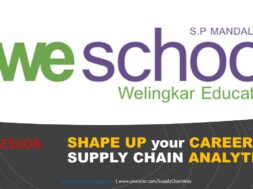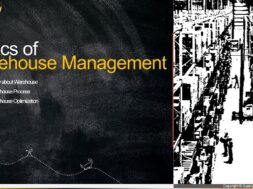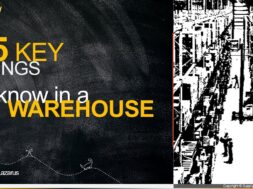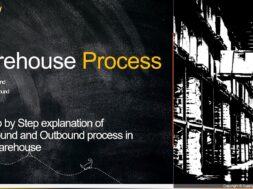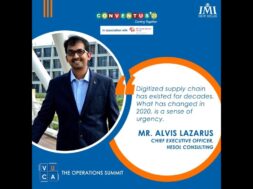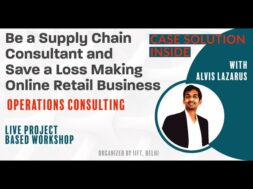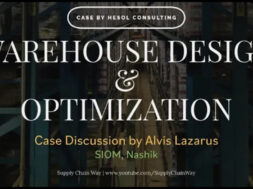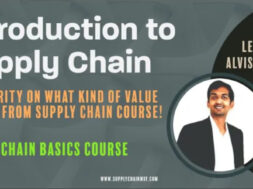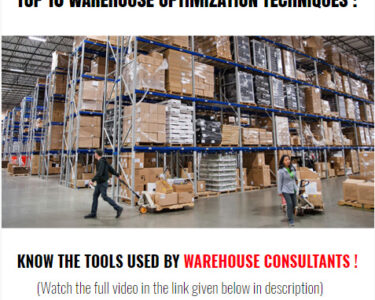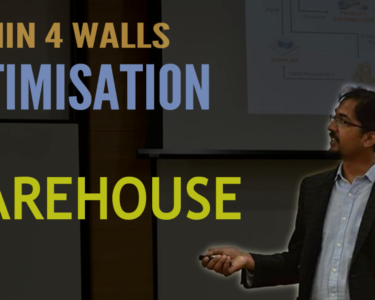WeSchool (Welingkar Institute of Management) Supply Chain Analytics Career Session by Alvis Lazarus
In this session, we are going to focus on getting your questions and answers. Prior to that, I am going to give you some insights about the Supply Chain Analytics Market Globally as well and going to give you an understanding of what is the size of this market and how it is growing!!
It is estimated to reach around 16 to 20 billion US Dollars by 2024 that is the end of 2024 out by early 2025 and it is growing at a cagr up around 17%. So that means there are lots of new products, technologies, and Service-oriented Supply Chain Analytics.
In the above picture, I am going to explain to you how Analytics plays a crucial role here. So this is a very quick schematic diagram of what happens in a Supply Chain. If you see there is a set of Supply planning and demand planning. This is a planning side of the supply chain which then feeds this demand into the engine and then their job is to ensure the raw materials are brought and then there is manufacturing which converts raw material into the finished product and then distribution engine fix in their job is to take the finished products to the N customer. So there as well in demand planning, if you talk about any analytical tools on forecasting how to define Forecast anything related to demand forecasting it will play a crucial role over here.
How is my leave times are there what’s kind of variability on that, how can I quantify uncertainties in the supply area, all those things will come in terms of the Supply planning? One thing which is always been talked about in terms of how predictable customers are, that is on demand-side plus customer behavior. Even on the supplier side how the supplier behaves though he’s telling that I can do this what he is potentially possible to do it there as well you can work on a lot of analytics side of it.
Network strategy is one of the biggest decisions you will take in the Supply Chain within the distribution. Distribution Analytics will cover all the Network related decisions in warehouse-like how to put products and insured space is utilized well, a material flow related things predicting what is the probability that products reach to my customers on time. Analytics can fit into every function and every decision making of Supply Chain.
Here I will quickly share with you Scam Model. Two things you have to keep in mind one is the Gartner model, which you have gone through it which is descriptive analytics, Diagnostic and predictive, and prescriptive. It will guide you to find out whether your career is going up or not.
The second thing you should also understand the Scam model because this is how you drive the project’s business case validation solution design implementation. If you somehow got stuck up in the first phase itself then you will be clear that your growth is not happening in the Analytics field and you need to either switch your job within the organization or you need to find a job outside.
There are many ways you can build your career within an organization that has analytics as a vertical you can do that or you can join a service provider lot of organizations are now giving analytics as a service.
The last one you can also be a part of the research. So there is a good chance of being an individual contributor you can be as a data scientist do your Ph.D. you can go that way as well or if you want to go into a CXO level role then you need to acquire the knowledge on problem-solving as well as the team management.
So these are the key takeaways from the video which I want to give as a nutshell.
Question: There is a business analyst role, what kind of skills are required to solve a problem efficiently, and what are the multiple factors on which we design the solution and how we prioritize the solution?
Answer: Let me explain this in two different ways first and foremost you should all understand the business analyst that could be different meanings. So this is the place where the analytical ability plus the functional ability merges. So nevertheless even when you are working on a junior-level analytic role, I would even suggest you always acquire functional knowledge otherwise it is very difficult to do your job better. Coming back to the question First and foremost thing for a business analyst to do problem-solving, he should have functional knowledge as well. Let’s take a very specific example to assume this is a business analyst working on a manufacturing line, the case is, the line is not delivering as per the industry-standard. Let’s put like that we did a competitor analysis and we have realized the manufacturing ability basically the throughput is not in part with the competitor. For example, Now you need to use the business analyst has to come up with a problem so what he will do, he has to first collect all this data so that he’ll be forming a team, he may work with different analytician to collect all this data look at the past data for this defiantly the other roles which I talked about the data architect and data analyst these people are required, but once the data is there he has to read it so that means a first and foremost thing for that business case the business analyst should have good knowledge about manufacturing. So what happened he should know terms like what is Throughput time, how to do a line balancing, what is a workstation, line side, what is point-of-use whatever I am all talking about all these are manufacturing and Manufacturing Logistics related term. So first and foremost thing is functional knowledge number one.
Number two is Problem-solving tools: the moment you got all these data you need to get meaning out of it. You can directly put that into some software though there are a lot of tools available that will give you the final solution but you need to build that data set. So for that, I would suggest a good knowledge of statistics. What statistics do is again there are two sets of statistics without going much into detail descriptive statistics which you use statistical tools you can use statistical software to put this data get the insights from the data. This is what you doing in descriptive statistics. The second one you will use predictive statistics if required to find out how this data could behave in the future, these are the two things you will do. The third one either has to build analytical models to do a simulation or you can use some of the existing built analytical models. Now that will give you a lot of insight. Finally, You can use any of your problem-solving abilities it could be another set of tools solution design tools or you leverage your experience and knowledge on the manufacturing line what I just talked about and then you come up with the solution, not just that moment you have the solution again you go back to analytics to find out what could be the outcome what could be my return on investment do a comparison and then finalize, okay this is the right solution for my organization and then move forward. This is a nutshell of what the business analysis has to do.
Question: In India what is the scope and what are the different businesses we can target after completion of an MBA, become Supply Chain Analyst, or Operational Analyst?
Answer: Let me put in this way, very important and this question is going to trigger a lot of thinking process in you. Logistics in India is a kind of fragmented stage it is so unorganized and What you said in terms of an if I see overseas it all streamlines that is not the case. We work with almost 20 different countries in terms of logistics there as well Customers give importance only to cost. And only those specific requirements which are enforced by law is getting followed, rest of the things there also very difficult to sell any Technologies, I just completed a keynote delivery on Global Logistics in a conference. Customer behavior is just changing post-COVID to see something outside the cost in terms of I am ready to pay for the value. So let’s keep it in this way that overall as logistics always technology to get adopt at this point of not everyone is interested but that thing is changing. Second thing if you are very passionate about Analytics, you should really get excited when you see results. So, in that case, an Industry that is very unorganized like an Indian Logistics scenario will be much more exciting to you because the data sets are not available good and the industry itself pretty much is not organized. This gives you actually a good amount of challenges and that is where statistics can now play a great role in terms of quantifying that uncertainty, that is number two.
Number three, You talked about automation to this automation predominantly driven by a product and any data which is collected by the product then you do some analytics around it but there is not much uncertainty because the data sets are all cleaned up and ready, so you need to choose. Now either you want to get into a sector where there is currently a lot of opportunities that mean there more and more opportunities will come in from an analytics standpoint. So to me personally asked I would tell you those kinds of things rather than taking something very stabilized where already a lot of automation is available. The Indian logistics industry is a great pick because more and more now customers are asking where is my product I want it now they’re concerned about lead times they want to keep the product stop near to the customer point itself, close to the delivery point itself. So all these things are happening and more and more analytics scope is increasing in this area. So that’s the answer to the question.
Follow up Question: What are the other industry that we should target?
Answer: If you’re asking is other Industries I would suggest, first let me put within the supply chain where everything is used before I get to the sectors and other nuances on that. First and foremost thing more and more analytics penetration is happening on the distribution that is your transportation and warehousing because this is going to be the future. Because it manufacturing kind of stagnation has happened in the sense from a competitive edge standpoint now moment people tell Supply Chain they focus on warehousing and Transportation or they call it as a logistics that is defiantly one area you need to split that into completely two warehousing and transportation the requirement has completely different. Second one Planning. If you see my video on ‘what makes supply chain so complex and exciting’, the points completely whatever I talked about right from customer behavior quantifying the uncertainty working on sale house everywhere there is abundant scope for analytics. So you can pick specifically Planning by which you are quantifying the uncertainty second great area where analytics is going to play a role.
The third one is Analytics given as a service which is completely different but there as well the scope is getting increasingly more and more opportunities are coming here. In terms of Sector, In my opinion, Automotive Tops it all because they’re already stabilized with lean Six Sigma theory of constraints and everything. So they are already very familiar with using these data and now the next step is getting into a core analytics engine and they are ready to invest in building to their own systems itself. So there is a huge potential. Another specific sector that I want to talk about is retail both offline and online. Huge Opportunities is coming in, you can think about FMCG or even other sectors like an Fmb. Everywhere retailing specifically not wholesaling the reason why retailing comes up with millions and trillions of data sets, and it’s becoming very difficult to get you. Won’t believe FMCG industry past decade once they shipped out the product and they won’t even have any data after that what happened how many hands are moved completely the distribution Channel holds that data point. So now things are opening up, people want that data, people want customers behavior data and lots of scope for Analytics over there.
Thank you.
Question: In your Linkedin post I read about processed stabilization followed by technology. Can you elaborate on your experience or Consulting career or any real-life instance?
Answer: Let me put this way assume let’s take a very hypothetical example rather than even picking specific because that will take a long time to explain. There is an organization A. And that organization has a lot of consistency issues that means whether they are achieving object that is completely different they’re not consistent. One time they produce, for example, they manufacture fans. One day they produce a thousand pieces the next day they do only two hundred and one days there is complete shutdown is kind of chaotic, I’m just giving you the extreme. Now in that organization you are going and implementing any technology absolutely what that means is you are considering the outline scenarios the worst the best. And this extreme is always heading towards failure.
The post that I put in is very specific to ERP. What happens in an ERP the gentle thinking is: My competitor organization has got as software X and ERP. And they gain so much out of it now I put the same software it works for me and it will solve all my issues, absolutely not what will happen is the ERP will be bought, it will be given to the operations team, they will see things are not working out, they’ll keep that software aside start working on again excel sheet and Google sheet. This is the ground reality. Why this happens because you have not mapped your process. Understood what are all the wastage in a process and then go for a solution. So what’s the right process I will tell you the First state is current state mapping go and find out what I do currently. Today what is the way I work you need to document that. Again document there are different ways, we are not talking about that you documented, then you are finding out. These are all actually non-value-added activities. You won’t even if you want to use it as lien language use it otherwise you can tell these things don’t add value to me. So now as an organization, you come back and say I need to eliminate all these non-value-added activities. Now to do that you go to the market and find out how can I solve this. To solve this now you come up with an option of software then it is great because you’re merging your issue with that one. Now you map the process you know what are all the issues you are basing that you’re going to the market. You’ll find now what are the things that can be solved by that tool or technology and what are the things it can’t. Before it can add value what are the things I need to do this is the process of transformation. So first you do the process of transformation to a level from where the technology can take over till then you need to do a process transformation. Part of the process of transformation then you bringing the technology at the end where your processor stabilized. Now you make it optimized and efficient with the same resources that can deliver more or it can same resources, same speed of the execution but the defects and issues are less what it could be. So this step goes toward winning. The probability of win this approach is much higher.
Thank you.
Question: When you are talking about the Supply Chain analytics then India is actually growing like sme sector or online purchasing in all. So we are not just talking about big companies like Flipkart or Amazon. There will be a smaller company not have enough infrastructure to establish the entire system for Supply Chain analytics.
As a student or as a job Seeker how the job will look like, will it be an outsourced base job that Supply Chain analytics is done by some external companies also when this job is outsourced then what is the criticality of the data they will be sharing with them because it will be very vital for them?
Answer: The point what you talked about in terms of small and medium Enterprises using analytics and bigger company using analytics. Now let me put this way from a career standpoint: If an organization is not giving importance to the complete analytics vertical, it is very difficult, you won’t get a great experience from that organization. So before you get into an organization doesn’t matter whether it’s a Fortune 500 mid-size organization whether Mnc or Indian company whether it is sme startup doesn’t matter. Preferably you see a mid-sized organization, at least there an operation for 10 to 15 years so that is a good time. See what importance they give to Analytics. How the analytics roles up in their organization chart bases that you can take a call number one.
Number two: Some cases the analytics as a portion is embedded into a role that is another exciting thing so for example in caterpillar when I worked I was a Lean and Six Sigma consultant like I’m kind of an internal consultant. The role is I need to solve the problems whichever comes in for Caterpillar difference with facilities across the globe. For that, I am equipped with statistics and analytical abilities in the form of tools and knowledge. That is an excellent role because you get to do the functional side of it and in your tool kit you have the analytical ability. This is another way of doing setting up your career. So in that case, what you need to do you need to pick up roles to the problem solving and no one is going to bother you whether you have used analytics or not. Everyone will be expected results that’s mean you have the flexibility to use Analytics.
The third one is product development companies where you can go as a scientist. And then be part of the research and come up with something new.
The fourth one is as a core operations role with Analytics roles is called process Excellence roles. So there as well what is expected out of you is very simple you take the process from one step to the next step you can do that or you can do analytics as a service but I’ll tell you a few important things, Analytics as a service you need to see it relayed on a product. Are they selling just one product like an Erp they have an analytics product they sell this product your work life will be completely revolving on that product? Are you fine with that, if you are fine with that you can still do projects, still you get hands-on but the language you talk the analytic everything revolves around that product, you need to keep that in mind or same analytics as a service, like for example Hesol giving Supply Chain problem solving as a service but we don’t have a single product but whatever product you will name you would have done some implementation in past five years. What does it means I am not selling a product I am doing problem-solving while solving the problem when I need for a technology I will go bring whatever technology we can bring an implemented that is another kind of way you can see it.
Third one Any organization you join in, for example, people call this as a control task that is not analytics that is dashboarding that is descriptive Analytics. Probably a knockdown form of descriptive analytics that role sometimes most important it doesn’t go because in that organization the teams though they call it is analytical team their job is to just report data. So you need to do research on the organization before getting in not about your job, how the analytical teams’ growth could be absolutely you need to do this groundwork. Only then because I can’t make a name and specifically tell then probably you have a role you can reach out to me I can talk about that organization probably has a one on one. But these tips what I give you, only you need to do their research on that organization before you get into that particular organization or that particular role.
Thank you.
Question: When you have placement like we are mostly trying to get in the analytics side so what level of statistical knowledge in descriptive predictive is being expected from us. Is it to the level of like modeling or do we need to have just knowledge of regression and what possibly a basic knowledge or level of knowledge like the gain model for operations role? A prescriptive analytics role also coming in this region or not.
Answer: Let me put it this way now, Operations let’s keep it very separately, operations we talked about execution. I was taking care of operations in 3M and Flipkart what is expected out of me is get things done as per plan. Their people will look for your team management definitely there is an analytical ability that will help you. But on you’re getting in no one as required as I told you, because I drive a lot of improvement projects that I’ve used analytical ability but that is not as required as prime skill set but it gives you an edge in that role because of core operations with this kind of process excellence or analytical ability very rare. With that let’s get into this analytics question. Based on what you said what level I need is again it answer lies in the Scam model. In the Scam model, if you start from the starting point of you started getting the data. What you need to complete statistical knowledge you can use a tool or you can do it in Excel itself because you know in out of it. But if the data is a very complex call out is there if you’re talking about say 1 million lines of data then you need a tool obviously that is a separate Big Data. In descriptive analytics, all you do is making sense out of your data that is you take everything to think about in Excel to take a date of what you do, do a cleanup then check by we probably do a histogram and check it. As simple as that and it can go as complex as well when your data is Big when the inside you need from that is very higher not just that if your data set not good there’s a lot of inconsistency that is where statistics play a role. So you should be a good statistician at that place.
The second step is now you need to Diagnostic also falls into that used to diagnose you basically what you can do as you should understand functionally. How I can make two-three different data sets and make some sense out of it. These two will come into it.
Now the second portion predictive and prescriptive this is a problem solving comes into it. To be successful here, You no need to be a great scientist level because the scientist and research kind of roles get into building something new. But the basic requirements for Step 1 in predictive and prescriptive is understanding functionally the area which you are applying those models. At least use the existing models and you should be able to drive the solution out of it. This is the key things. Ensure your journey is going up because definitely directly you can’t go into prescriptive analytics it is very difficult to catch up. So you start from a descriptive probably in one year I won’t suggest more than a year of maximum two years in descriptive analytics. You should move forward spend most of your time on predictive analytics. That is where your demand forecasting how my demand is going to behave. What would be my probability of on-time delivery what is my otif is going to be what is going to be my otif, on time in full. I am mixing the functional words as well as the analytical requirements that is what is expected on the predictive analytics.
Thank you.
Question: I saw the warehouse case study in Supply Chain way and I tried to read the whole I understood somehow but how to approach to complete the case studies I’m not getting currently, so how do I start a case study how to get the decisions making, how can we improve on that?
Answer: So what you just said is exactly the problem-solving approach. You need a good understanding so don’t be hard on yourself telling that you couldn’t solve this, it is bad. People the First time when they are coming into Consulting itself they could even have some 10 years of experience hands-on. The moment you got a live project on your hand you see everything you have all the tools at your shoulder but you don’t know where to start it. This happens for everyone and that is where the learning is also. So what you need to learn is more in terms of understanding of for example warehouse case study is a very tough one. So obviously you can read one article on our website which talks about warehouse optimization where I would have explained what is RSQ how to do space planning that would help you to give you some understanding.
Thank you.
If you have any follow-up questions, you can use the Supply Chain Way Forum you can just go to the
you can log in or even you can use those videos in YouTube channel of Supply Chain Way. Link is:
https://www.youtube.com/channel/UCICdCjmCc1oQcehGN9066xQ
I wish you all the best thank you so much.
